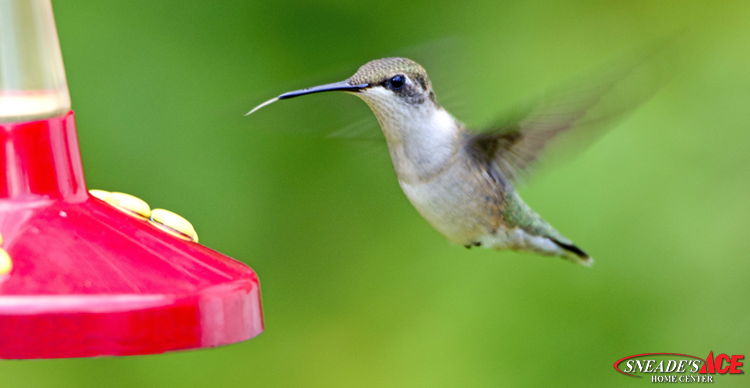
Mel often shares the phrase “Nature is God’s Stress Reliever–Take a Moment Today to Listen to the Birds Sing!” Whether it’s Purple Martins, Cardinals, Bluebirds, Hummingbirds, Orioles, Goldfinches or others–we’ll do our best in the months ahead to help you successfully attract and enjoy your favorites.
Want more hummingbirds? Tie a big red ribbon around an old oak tree. Dig out hose Christmas decorations and attach red bows on your deck, yard crane, or other places you want to attract hummingbirds. Red = Food for hummingbirds, and they’ll come by to check out your bow. Then have some red blooming flowers or a “clean” hummingbird feeder ready for them to enjoy and benefit from. Remember by “tax day”, April 15, to not only give the government its due, but also hummingbirds. Have your feeder up by then. I stress, you must keep hummingbird feeders “clean”, as feeding from a dirty feeder is like a “DWI” for a hummingbird. Mold and mildew on a feeder or spoiled nectar throws off a hummingbird guidance system. A hummingbird beats its wings about 78 times per second so staying in total “control” is critical. As a result, hummingbirds will avoid a dirty feeder. There are feeders available that are totally dishwasher safe. Look for these and always buy feeders that come apart easily and feature wide mouths to the nectar reservoir.
When buying feeders, avoid products with yellow ports or parts. Yellow is one of the few colors bees can see and they are attracted to it. If you own one of these, use fingernail polish to paint the parts red. You can also use Avon “Skin So Soft” to safely discourage bees and wasps. Just put a little “Skin So Soft” around the feeder port.
Besides wasps and bees, another insect that can cause problems in hummingbird feeders is ants. You can keep ants from getting in your feeder by hanging the feeder from an “Ant Moat or Nectar Protector.” You fill these devices with water–ants can’t swim and thus can’t get to the feeder (I’ve built out of tuna cans or film canisters with children).
When planting flowers for hummingbirds, I recommend you use native plants whenever possible. Bee Balm, Trumpet Vine, Scarlet Dropmore, Honeysuckle, Columbines and Cardinal Flowers are some of my favorites for East of the Rockies. In hotter, drier climates, there are other species to select. Regarding annuals, always go with flowers with feature wide-open throated blossoms that are easier for hummingbirds to feed.
A couple of other things you can do to attract hummingbirds is to provide a “mist” of water, a plat of rotting fruit or nesting material. Because Hummers go in and out of hundreds of flower blossoms each day, they get covered with a lot of pollen. Hummers look for a way to clean their feathers. A fountain that splashes or a shallow bird bath is sometimes used by hummers for this purpose. Better yet providing a mist they can fly through is a guaranteed way to attract hummingbirds. In fact, if you put your water supply on a timer, you’ll actually have hummers lining up daily, as if it’s time for “Saturday Night Baths”. There a commercial misters available at farm and home stores that can be adapted for this purpose or a soaker hose can also work if strung thorough the air. You can also buy nozzles developed specifically as bird misters. Try mist–it’s a guaranteed hummer “Magnet”.
Did you realize that while hummingbirds use nectar as their energy source, small insects are a hummingbird’s source of protein and minerals? This is also true for butterflies. A proven way to attract lots of both hummingbirds and butterflies is to put out a plate of fruit (watermelon, peaches, bananas, are the best!), and let is rot. This results in lots of small fruit flies that butterflies and hummingbirds love. TO keep my wife happy, I hide the plate in the middle of a bed of flowers. In the meantime, don’t forget to serve fruit and both butterflies and hummingbirds will flock to your yard!
Last, but not least, all bird species respond to you when providing them nesting material. Feathers, dog and human hair and small lengths of yarn (no longer than 4-6 inches as birds can get tangled in yarn if it is longer) all are readily used by a wide variety of songbirds. For hummingbirds, there’s only one proven nesting material and it must be purchased commercially. In areas where there are multiple species of hummingbirds (east of the Rockies, most folks get just Ruby Throats) the material is worth providing, as it can dramatically increase the number of hummingbirds nesting on your pond banks or in your backyard. The product is called “Hummer Helper Nesting Material” and is endorsed and recommended by The Hummingbird Society. A bonus is goldfinches love it too! If you use some of the above suggestions, you should soon have lots of hummers zipping around your yard or pond. Want to learn more about hummingbirds, check out www.hummingbirdsociety.org.
“Bird Man Mel” Toellner is the owner of Songbird Station, the Largest Seller of Backyard Nature Products in North America.
